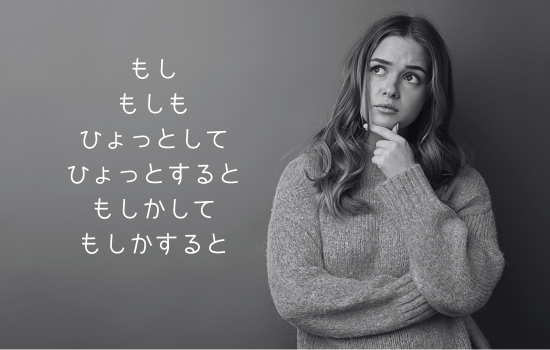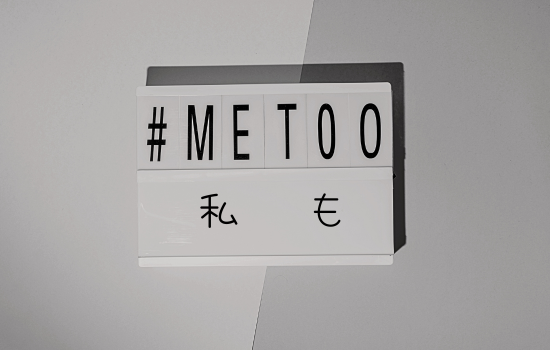The Japanese expressions “〜と,” “〜たら,” “〜ば,” and “〜なら” are all used to indicate hypothetical situations or conditions, but each has its own unique nuances. Depending on the context, they may be interchangeable, but subtle differences can affect the overall meaning. By understanding how to differentiate these forms, you can use more natural-sounding Japanese.
Additionally, I will also cover the advanced and more casual expressions “〜んだったら” and “〜んなら,” which are commonly used in daily conversation.
1.「〜と」 → “When”
(Definite Condition; Tense: Present/Future/Past)
「と」 is used to express a condition with a high degree of certainty, indicating that whenever one action happens, a particular result will inevitably follow. It is primarily used in the present or future tense to denote general truths, habits, or natural laws.
Examples (Present/Future Tense)
- 春になると、桜が咲きます。(はるに なると、さくらが さきます。)
— “When spring comes, the cherry blossoms bloom.”
Examples (Past Tense): - 私が手を振ると、子供たちが走ってきました。(わたしが てを ふると、こどもたちが はしって きました。)
— “When I waved my hand, the children ran toward me.”
Point: While 「と」 can be used with past actions or events, it is often used to emphasize a direct causal relationship between the two events. Therefore, it is suitable for contexts where actions occur consecutively.
Caution: 「と」 does not naturally pair with sentences involving volitional actions or requests. For example, 雨が降ると、傘をさします。(あめが ふると、かさを さします。)ー”When it rains, I’ll put up the umbrella” is natural, but “雨が降ると、傘を持っていきます。(あめが ふると、かさを もって いきます。)ー “When it rains, I’ll take an umbrella” feels slightly unnatural.
2.「〜たら」 → “When”
(Realizable Condition; Tense: Future/Past)
「たら」 is used to indicate a realistic condition or hypothetical situation. It suggests the result or subsequent action based on a particular future or past condition, often reflecting the speaker’s subjective judgment or emotions. The certainty is lower than with 「と」, and the realization of the condition is somewhat uncertain.
Examples (Future Tense):
- 彼が来たら、嬉しいです。(かれが きたら、うれしい です。)
— “When he comes, I’ll be happy.”
Examples (Past Tense):
- 彼が帰ったら、家がとても静かになった。(かれが かえったら、いえが とても しずかに なった。)
— “When he went home, the house became very quiet.”
Point: 「たら」 can be used to create past conditional statements, making it versatile for describing events based on past scenarios.
Caution: 「たら」 has a slightly casual tone and is frequently used in everyday conversations.
3.「〜ば」 → “If” or “When”
(Hypothetical Condition; Tense: Future)
「ば」 indicates that if a certain condition is met, a specific result will follow. It is used for expressing hypothetical or general conditions and has a modest tone. While it is closest to “If” in English, if the condition leads to an inevitable result, it can be translated as “When.” It is mainly used for future scenarios.
Examples:
- 雨が降れば、家にいます。(あめが ふれば、いえに います。)
— “If it rains, I’ll stay home.” - お金があれば、旅行に行きたい。(おかねが あれば、りょこうに いきたい。)
— “If I have money, I want to travel.” - 行けば分かるよ。(いけば わかるよ。)
— “If you go, you’ll understand.”
Point: 「ば」 is suited for hypothetical conditions, and it is less concrete than 「たら」, making it ideal for sentences focused on possibilities.
Caution: This expression is relatively formal and thus suitable for business settings.
4.「〜なら」 → “If”
(Hypothetical Condition or Suggestion; Tense: Present/Future)
「なら」 expresses a condition or suggestion based on current information or future assumptions. It is used when the speaker gives an opinion or judgment based on existing information, making it the closest in nuance to “If” in English. It can easily establish flexible conditions and is frequently used for proposals or opinions.
Examples:
- 明日雨なら、ピクニックは中止です。(あした あめ なら、ぴくにっくは ちゅうし です。)
— “If it rains tomorrow, the picnic will be canceled.”
Point: Since 「なら」 is based on the speaker’s understanding or perception, it often makes the hypothetical condition concrete.
Caution: It gives a softer impression, making it suitable for casual conversations.
Using “〜と, 〜たら, 〜ば, and 〜なら”: Tense and Context
All of these expressions are used to indicate conditions for future actions or hypothetical scenarios, but their tense and nuances vary.
Differences in Tense
- 「〜と」 is most often used to describe current habits or general truths. It can also be used for past actions as conditions. It is suitable for stating definite conditions.
- 「〜たら」 easily adapts to the past tense and is ideal for forming conditional sentences based on past events. It can also express future conditions.
- 「〜ば」 is suitable for expressing general conditions, often focusing on hypothetical scenarios. While it is similar to 「たら」, it has a slightly more formal impression.
- 「〜なら」 is often used for expressing suggestions or judgments based on current or future conditions. It is most suitable for expressing opinions based on specific information.
Tips for Differentiation and Interchangeability
Although these expressions differ in tense and nuance, in casual conversations they are sometimes interchangeable. For example, in expressing real conditions or proposals, 「〜たら」, 「〜ば」, and 「〜なら」 can be replaced depending on the context.
Example:
- 雨が 降ったら/降れば/降るなら 、ピクニックは中止です。(あめが ふったら/ふれば/ふるなら、ぴくにっくは ちゅうし です。)
— “If it rains, the picnic will be canceled.”
In the above example, any of the expressions would work, but subtle nuances arise:
- 「たら」: Indicates a specific condition.
- 「ば」: Focuses on the condition itself, with a slightly more formal tone.
- 「なら」: Emphasizes the judgment or proposal based on the condition.
The Certainty Levels of 「~と, ~たら, ~ば, ~なら」
The levels of certainty from highest to lowest (1. Most certain → 4. Least certain):
- 彼が来ると、嬉しいです。 (かれが くると、うれしい です。)
— “When he comes, I’m happy.”
Explanation: This sentence expresses a definite condition or habitual action. When the condition of “彼が来る (かれがくる)” is met, the result “嬉しい (うれしい)” will always occur.
● Most Certain: Used for general facts, natural laws, or conditions that always lead to the same result. - 彼が来たら、嬉しいです。 (かれが きたら、うれしい です。)
— “When he comes, I’m happy.”
Explanation: This sentence indicates that “嬉しい (うれしい)” will be felt after a specific event, “彼が来た (かれがきた).” It is viewed as a specific future action, making it relatively high in certainty.
● Specific Event: Used when referring to scheduled events or situations where the person’s arrival is expected, making it more certain than 「ば」. - 彼が来れば、嬉しいです。 (かれが くれば、うれしい です。)
— “If he comes, I’ll be happy.”
Explanation: This sentence expresses a hypothetical condition, meaning “If he comes, I’ll be happy.” It is uncertain whether he will come or not, focusing on the choice of whether he will come or not.
● Hypothetical: The focus is on the potential condition, making it less certain than 「たら」. - 彼が来るなら、嬉しいです。 (かれが くるなら、うれしい です。)
— “If he’s coming, I’m happy.”
Explanation: This sentence represents a hypothetical scenario based on existing information or the speaker’s understanding. Whether the condition will be fulfilled is still undecided and is being considered as a possibility.
● Least Certain: Used for suggestions or expressing opinions, with low certainty and dependent on the situation.
たら vs ば:
「〜たら」 often indicates specific events or situations and can also be used as a condition, but it frequently represents temporal continuity or future events, making it slightly more certain compared to 「〜ば」. However, for native speakers, when discussing uncertain future hypotheticals, 「たら」 and 「ば」 are almost interchangeable and hold nearly the same meaning.
[Example 2.] 彼が来たら、嬉しい。 (かれが きたら、うれしいです。)
— “When he comes, I’ll be happy.”
[Example 3.] 彼が来れば、嬉しい。 (かれが くれば、うれしいです。)
— “If he comes, I’ll be happy.”
For native speakers, there is little difference between these two sentences, and they are both used frequently in the same context in everyday conversations.
However, when expressing a specific, expected action to the listener, 「たら」 is preferred over 「ば」.
Example:
- Natural: 彼が来たら、連絡してください。 (かれが きたら、れんらくして ください。) — “When he comes, please contact me.”
- Unnatural: 彼が来れば、連絡してください。 (かれが くれば、れんらくして ください。) — “If he comes, please contact me.”
Explanation:
This sentence assumes a specific future event, “his arrival,” as a premise. In this context, rather than focusing on the condition, the emphasis is on the sequence of actions, i.e., “When he arrives, please take the next action.”
“彼が来たら、連絡してください。 (かれが きたら、れんらくして ください。) ” suggests that his arrival is expected, and it conveys that the speaker wants to be notified once the condition is met.
However, “彼が来れば、連絡してください。 (かれが くれば、れんらくして ください。) ” suggests a lower likelihood of his arrival, focusing more on the hypothetical aspect and making his arrival seem less certain.
Example:
Correct: 彼が来たら、パーティーを始めましょう。 (かれが きたら、ぱーてぃーを はじめましょう。) — “When he comes, let’s start the party.”
Incorrect: 彼が来れば、パーティーを始めましょう。 (かれが くれば、ぱーてぃーを はじめましょう。) — “If he comes, let’s start the party.”
Explanation:
In this case, using “たら” assumes that “his arrival” is seen as a certain future event, and the speaker is setting the next action based on that. Using “ば” would imply that “his arrival” is not definite and the plan for starting the party is still uncertain.
5. 「〜んだったら」 → “If (you are) going to / If that’s the case” [Advanced Level]
(Expresses a condition based on the speaker’s judgment or suggestion, tense: present or past)
“〜んだったら” is used to express advice or suggestions based on the other person’s intentions or actions. Using the past tense (〜んだった) conveys a judgment about something that has already happened, and can include nuances of regret, reflection, or pointing out a past situation.
Example:
- 忙しいんだったら、無理しなくていいよ。(いそがしいんだったら、むりしなくて いいよ。)
— “If you’re busy, you don’t have to push yourself.”
Explanation: The speaker acknowledges the other person’s busy schedule and offers advice based on that situation. - 彼が来るんだったら、席を用意しておこう。(かれが くるんだったら、せきを よういしておこう。)
— “If he’s coming, let’s prepare a seat.”
Explanation: Based on the information that “he’s coming,” the speaker decides on the next action. - もう帰るんだったら、一緒に行きましょう。(もう かえるんだったら、いっしょに いきましょう。)
— “If you’re going home already, let’s go together.”
Explanation: The speaker proposes an idea based on the premise that the listener intends to go home. - こんなことになるんだったら、言わなきゃ良かった。(こんなことに なる んだったら、いわなきゃ よかった。)
— “If it was going to turn out like this, I wish I hadn’t said anything.”
Explanation: The speaker regrets their past action because of an undesired outcome.
Key Points:
This expression is used when making suggestions like “It’s better to do (something)” or “You shouldn’t do (something)” based on the other person’s circumstances. It’s particularly effective when referring to past information as a basis for judgment.
6. 「〜んなら」 → “If (you are / it is)” [Advanced Level]
(Similar to「〜んだったら」, but used in more casual contexts)
“〜んなら” is used when the speaker wants to respond quickly to the listener’s intentions or thoughts. It is more casual than “〜んだったら” and is suitable for conveying spontaneous advice or decisions during a conversation. It is most often used for present or future events.
Examples:
- 忙しいんなら、無理しなくていいよ。(いそがしいんなら、むりしなくて いいよ。)
— “If you’re busy, you don’t have to push yourself.”
Explanation: The speaker considers the other person’s situation and suggests not to overdo it. - 彼が来るんなら、席を用意しておこう。(かれが くるんなら、せきを よういしておこう。)
— “If he’s coming, let’s prepare a seat.”
Explanation: The speaker proposes getting ready, based on the premise that he will come. - こんなことになるんなら、言わなきゃ良かった。(こんなことに なる んなら、いわなきゃ よかった。)
— “If it was going to turn out like this, I wish I hadn’t said anything.”
Explanation: The speaker expresses regret over a situation that resulted from something they said.
Key Points:
“〜んなら” is a quick response expression that matches the flow of conversation. It is useful for making light suggestions based on the other person’s actions or situation, such as “Let’s do this” or “It’s better to do this.”
Caution: Since it’s a quick response based on the speaker’s judgment, it can sometimes sound pushy or presumptive. Avoid using it with superiors or in formal situations.
- 帰るんなら、一緒に駅まで行こう。(かえるんなら、いっしょに えきまで いこう。)
— “If you’re going home, let’s go to the station together.”
Explanation: The speaker suggests going to the station together based on the other person’s decision to leave. - 辞めたいんなら、辞めて良いよ。(やめたい んなら、やめて いい よ。)
— “If you want to quit, it’s okay to do so.”
Explanation: The speaker respects the other person’s feelings and acknowledges their decision.
Summary of 「〜と, 〜たら, 〜ば, 〜なら, 〜んだったら, 〜んなら」:
- For inevitable consequences → “〜と”
Expresses a causal relationship where B always happens when A occurs.
e.g.
春になると桜が咲く。(はるになると さくらが さく。)
— “When spring comes, cherry blossoms bloom.” - For general conditions or future events → “〜たら”
Assumes a future situation and states the resulting action.
e.g.
明日雨が降ったら、家にいる。(あした あめが ふったら、いえに いる。)
— “If it rains tomorrow, I will stay home.” - To clarify conditions → “〜ば”
Indicates a result that will happen if the condition is met. Stronger emphasis on the condition.
e.g.
行けば、会えますよ。(いけば、あえますよ。)
— “If you go, you will be able to meet (them).” - For making specific assumptions or suggestions → “〜なら”・”〜んなら”
Used to make suggestions based on the listener’s statement. “〜んなら” is more casual and friendly.
e.g.
行くんなら早く準備してね。(いく んなら はやく じゅんびしてね。)
— “If you’re going, prepare quickly.” - When assuming definite information or background → “〜んだったら”
Based on the other person’s situation or past facts.
e.g.
行くんだったら、私も行くよ。(いく んだったら、わたしも いくよ。)
— “If you’re going, I’m going too.”
Final Note:
By mastering these expressions, you can use Japanese more naturally and with subtle nuances. There are even more formal expressions for business contexts or specific situations, but this article covered the most commonly used conditional expressions in daily conversation.






